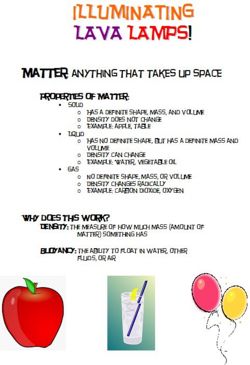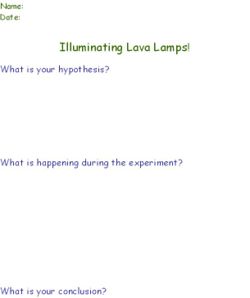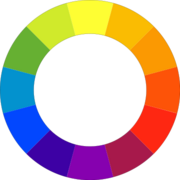Illuminating Lava Lamps
| Instant wiki maker | Making handouts | Editing tips |
Biology In Elementary Schools is a Saint Michael's College student project from a course that ran between 2007 and 2010 and fully described in this book chapter. The student-created resources have been preserved here for posterity. Link under 'toolbox' for printer-friendly versions of the exercises. Click on handouts to print full resolution versions. Please see Wikieducator's disclaimer, our safety statement, and the Creative Commons licensing in English and in legalese.
Student worthiness
Tried and trusted.
Primary Biological Content Area Covered
- Density and Buoyancy
- States of Matter
Materials
Teacher and Student Use:
- 473 ml bottle (16 US Fluid Ounce) or a 2 Liter bottle
- Vegetable Oil or Mineral Oil
- Food Coloring
- Water
- Flashlight(optional)
- Glass or plastic Funnel
- Alka-Seltzer
| Alka-Seltzer | |
| Wikipedia has an article on this subject.
Visit Alka-Seltzer for more in depth information |
Refer to Figure 2
Handouts
- Refer to Figures 1 and 12
Description of activity
This experiment will test the states of matter (solids, liquids, and gases) along with density and buoyancy.
For this activity students will first produce a hypothesis regarding what will happen when the states of matter (solids, liquids, and gases) are combined and how they will react. The experiment begins by having the students fill a 473 ml plastic bottle 3/4 of the way full with vegetable oil. Students will then fill the remainder of the bottle with water. (Make sure that students do not overflow the bottle). Then, have the students add 10 drops of food coloring to their bottle. When the bottle has been prepared with the vegetable oil, water, and food coloring, have students place one alka-seltzer tablet into the bottle. (Break the alka-seltzer tablet into smaller pieces, to make the effect last longer.) He or she can also add multiple tablets for multiple effects. Once the alka-seltzer is placed into the bottle, the liquid will begin to bubble. When the bubbling stops have the students seal the lid of the bottle, and tip the bottle back and forth. The liquids will then combine into one large blob and move up and down. Students have now created their own lava lamp! Flashlights can be placed underneath the bottles for an illuminating effect.
Lesson plan
- Students will receive a handout on the properties of matter and density. They will learn to identify each state and how it is connected to the experiment they are about to perform. At this point an explanation of the experiment at hand will be given. (Addressing second standard)
- Students will then be instructed to form a hypothesis, based on what they think will happen when the three ingredients are mixed. In regards to the students forming their own hypothesis, the students will be given guiding questions. For example: "What do you think will happen when the water and oil are combined? What will happen when the alka-seltzer is added? The purpose of the students formnig a hypothesis, is to see if students understand what happens when different types of matter are combined. Students will also have to explain their reasoning behind their hypothesis. They will write their hypothesis down on a handout that will be given to them during class. (Addressing first standard)
- The teacher will then demonstrate the experiment using a 2 Liter plastic soda bottle for the students to visualize what they will be doing in their own 473 ml plastic bottle.
- First fill the soda bottle 3/4 full with vegetable oil. Refer to Figure 3
- Add water to the remainder of the bottle, which will be almost to the top but be careful not to overflow. Refer to Figure 4 and 5
- Once the water is added, add 10 drops of food coloring.Refer to Figure 6 and 7
- Cut the alka-seltzer into 8 pieces. Drop one of the pieces at a time into the soda bottle, oil water mixture. The mixture will start to bubble. Wait until the bubbling stops and add another piece. Continue this added process until there is no more alka-seltzer left. Refer to Figure 8. 9. 10
- Finally, screw on the cap of the bottle and rock the bottle back and forth and watch the wave of lava appear. Refer to Figure 11
- For an added effect place a flashlight under the bottom of the bottle. This will illuminate the bubbles for a fun effect.
- Once the demonstration is complete the students will then be instructed, with the help of the teacher, to create their own lava lamp. They will repeat steps 4-8 to create their own lava lamp in their 473 ml plastic bottle.
- As each ingredient is added to the water bottle, students will be asked to record their observations in written form. For example, what occurs when the water is added to the oil? What happens when the food coloring is added? What happens when the alka-seltzer is added? Students will record what they see. Adults will first see what the students notice, and if needed, adults can ask the above guiding questions to the students. By recording this information, students will be able to look at their data and see if their hypothesis was supported or rejected. Refer to Figure 12. (Addressing third standard)
- If time allows, a discussion can take place as to what the states of matter were in our experiment. The solid was the alka-seltzer, the liquids were the vegetable oil, food coloring, and the water, and the gas was the carbon dioxide which was produced by the alka-seltzer. (Addressing second standard)
- Photographs of the experiment in progress
<kaltura-widget kalturaid='nm1l98nq3k' size='M' align='L'/>
Potential pitfalls
- Note:Do not seal the water bottle until the alka-seltzer tablets have dissolved. The alka-seltzer could build up pressure, and a mess may occur!
- If food coloring gets on students clothing, there is a possibility that it will stain their clothes.
- When using the funnel for putting the vegetable oil into the plastic bottle, be careful. The funnel becomes slippery and it may drop out of ones hands and break, as we experienced during our teaching with the students. It is a good idea to have either a wet sponge, or wet paper towels near by, as the oil will make a mess.
Artistic Connections
- This lesson can be connected to the color wheel, due to the fact that during this lesson students create a lava lamp with a distinct color, with the help of food coloring. The students can choose different colors and mix them together inside the lava lamps. With mixing different colors together, there is a possibility that a new color will be created!
- There are primary, secondary, and complementary colors that are found within the color wheel. When creating the lava lamps, the students can try to create a color that is found within the color wheel, by mixing different colors together. Color Wheel
- A flashlight or strobe light can be placed underneath or to the side of the lava lamps, for an interesting and fun effect. You can work with creating different lighting effects with the lava lamp.
- http://commons.wikimedia.org/wiki/File:BYR_color_wheel.svg (Picture of Color Wheel)
Literature connections
- Beech, L. 2007. The Exxon Valdez's Deadly Oil Spill. Bearport Publishing.
- "In narrative detail, The Exxon Valdez's Deadly Oil Spill chronicles the worst oil-spill disaster in U.S. history. Readers will meet Joseph Hazelwood, the Valdez's captain, who accidentally ran the tanker aground in March 1989, rupturing the hull and spilling gallons of oil into Prince William Sound." [3]
- Garrett, G. 2005. Solids, Liquids, and Gases. Children's Press.
Connections to educational standards
- S3-4:2 Students demonstrate their understanding of PREDICTING AND HYPOTHESIZING by…
- Identifying simple patterns of evidence used to develop a prediction and propose an explanation.
- S3-4:12 Students demonstrate their understanding of the States of Matter by…
- Identifying, describing and comparing the properties of selected solids, liquids and gases.
- S3-4:6 Students demonstrate their ability to ANALYZE DATA by...
- Interpreting patterns or trends in data...AND... Relating data to the original question and prediction
Next steps
- With those students who do not understand that water is more dense than oil, determine which of the two states of matter is more dense, oil or water. Measure the same volume of water and oil on a scale, to determine which one has more mass. Note: Measure water in cup, empty the water, dry the cup, and measure oil in the same cup used to measure the water, as it ensures the same mass of the cup. The cup would be the constant in the experiment, as it does not change.
- If you used different kinds of oil, besides vegetable or mineral oil, would the experiment still work? For example, would peanut oil work?
- A next step could also be to explain the formula found below. The students could learn that within an alka-seltzer tablet there are two main ingredients: sodium bicarbonate and citric acid. When the alka-seltzer tablet is placed in a liquid, a chemical reaction occurs, and the product of the reaction is carbon dioxide gas. Sodium citrate is also formed, but carbon dioxide is the central chemical which we are focusing on in this lesson.
| C6H8O7(aq) | + | 3NaHCO3(aq) | → | 3H2O(l) | + | 3CO2(g) | + | Na3C6H5O7(aq) |
| citric acid | + | baking soda | → | water | + | carbon dioxide | + | sodium citrate |
- Alka-seltzer could also be explored in the following activity:Density Rainbow
- This activity deals with the density of various liquids. Would the alka-seltzer react in the same way in the Density Rainbow activity, as it did in Illuminating Lava Lamps?
- The alka-seltzer tablet will sink through liquids that are less dense than the tablet itself. When the tablet reaches the water, a chemical reaction will occur, producing carbon dioxide gas. If there is a substance more dense than water, the carbon dioxide gas will probably not affect it. The gas is less dense than any of the liquids and it will float/rise to the top.
- This activity deals with the density of various liquids. Would the alka-seltzer react in the same way in the Density Rainbow activity, as it did in Illuminating Lava Lamps?
Reflections
I think that this lesson went really well with the group of students. Most of the students came to us with the background knowledge of what the states of matter are. I was very impressed that most of the students knew that water is more dense than oil. With this knowledge, they were able to form a hypothesis, and explain that when the water would be added to the plastic bottle with the oil, the oil would float to the top, as the oil is less dense than the water. It was also great to see that some of the students knew what the gas was in this experiment. It was carbon dioxide, which was produced by the alka-seltzer. I think that the students really enjoyed this lesson, as they were active participants in what was taking place. They could see the step by step process that it took to create the "illuminating lava lamps." If time allowed we could have talked about the two children's books that we chose to put under the Literature Connection piece, but we did not have time for that. I think that the students would have liked hearing about the book, The EXXON Valdez's Deadly Oil Spill, as it was a true story that took place in 1989. It's always good to relate what your learning in the classroom, to real experiences that happen in life. ~Emily
I think that our lesson went very well. The students seemed to love the experiment, and we received a lot of good feedback from them. We allowed the students to first think about what their hypothesis was, letting them explore their ideas about what they thought would happen when we put the Alka-Seltzer in the water and vegetable oil. They seemed to know a great deal about density and what would happen to the liquids in the water bottle. The students knew the differences between solids, liquids, and gases, and they were able to watch what happened when a gas was created in the liquids. They watched the carbon dioxide move through the liquids, moving the food coloring up and down through the liquids. I think this experiment went really well, and all the students seemed to enjoy it. I think this lesson was a success!
I believe our lessen went extremely well. Most of the students that we encountered already had a general understanding what the states of matter where and could identify examples of each. When we asked them to contribute a hypothesis for experiment, the students were able to show us that they knew that the water was going to remain separate than the oil. The students seemed to understand and know what was going to happen and they remained extremely excited. While they were performing the experiments we allowed them to explore the ideas of what would happen when each ingredient was added. They were told to added their thoughts and observations on a worksheet we had created for them. Their feedback was extremely helpful to us and provided results to show that they understand the nature of the experiment. I believe the students loved the idea of creating their own lava lamps on their own. They were able to share a feeling of accomplishment with those around them (peers, teachers, parents).
Citations and links
- This project was developed from the ideas at http://www.wikihow.com/Make-a-Lava-Lamp-with-Household-Ingredients and http://www.education.com/activity/article/Make_Homemade_Lava_Lamp/?cid=70.100
- Information for the "Illuminating Lava Lamps" handout was developed from http://www2.mcdaniel.edu/Graduate/TI/pages/LEWIS/matterweb.htm
- Book Description for The EXXON Valdez's Deadly Oil Spill came from: http://www.seekbooks.com.au/book/The-EXXON-Valdezs-Deadly-Oil-Spill/isbn/9781597163668.htm
- Beech, L. 2007. The Exxon Valdez's Deadly Oil Spill. Bearport Publishing
- Garrett, G. 2005. Solids, Liquids, and Gases. Children's Press.
- Alka-Seltzer formula and information, found under next steps piece, taken from: http://en.wikipedia.org/wiki/Alka-Seltzer
- A good article on the color wheel is the following: http://en.wikipedia.org/wiki/Color_wheel#Colors_of_the_color_wheel
- Color Wheel came from: http://commons.wikimedia.org/wiki/File:BYR_color_wheel.svg













